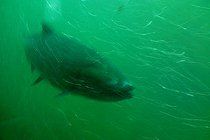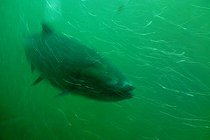Wild salmon populations decimated by fish farm lice
Marine cages filled with farmed salmon are breeding grounds for millions of sea lice, leading to high pesticide use which is killing fish. Sustainable salmon farming, whose population is suffering significant decline, is a myth, say experts.

 Marine cages filled with farmed salmon are breeding grounds for millions of sea lice, leading to high pesticide use which is killing fish. Sustainable salmon farming, whose population is suffering significant decline, is a myth, say experts.
Marine cages filled with farmed salmon are breeding grounds for millions of sea lice, leading to high pesticide use which is killing fish. Sustainable salmon farming, whose population is suffering significant decline, is a myth, say experts.
Lice feed on the mucus, tissue and blood of farmed salmon, and companies employ a range of measures, using highly toxic chemicals, to combat them, in an attempt to reduce the damage caused to their captive hosts.
However, wild fish that migrate from the rivers to the sea each spring, past fish-farm cages, are attacked by the unnaturally high numbers of lice. The fish are literally eaten alive, with death often hastened by secondary infections, contracted through open wounds made by the grazing lice.
The Norwegian media reported that scientists at the country's Institute for Nature Research (NINA) believe Norway's production of farmed salmon may be over six times larger than is sustainable. “We need to learn from others' mistakes, rather than blindly repeating them,” state The Atlantic Salmon Trust.
Populations of predator fish, such as salmon, at the top of the food chain have suffered huge declines – recently confirmed by Villy Christensen of the University of British Columbia's Fisheries Centre. Populations of predators, including cod, tuna and groupers, have decreased by around two-thirds over the past 100 years.
Christensen calls for consumers to protect species by shifting their diets from predators like salmon, tuna and cod, to their prey, such as coley, mackerel, herring and sardines.
The salmon farming industry and Scottish government appears determined to deny the environmental debacle emanating from fish farms, and they disseminate the myth of sustainable salmon farming.
Evidence is growing that salmon farms in Scotland are fast losing the battle against sea lice, states The Atlantic Salmon Trust. This echoes the situation in Norway, where Janne Sollie, head of the Directorate for Nature Management, has just called for a 50 per cent cut in salmon production because the average number of lice on each caged fish in several regions of Norway has exceeded the official limit.
Sollie said that such a cut might not be enough to save Norway's fragile wild salmon stocks as: "The problem is very big and it is not under control."
Compared to five years ago, Scotland's salmon farms are using far greater quantities of pesticides to kill sea lice on farmed fish as the chemicals become less effective and the lice develop immunity.
According to The Atlantic Salmon Trust, there are also too many fish escaping – over 133,000 reported in 2009, in addition to those that leaked from cages unreported.
Evidence suggests that escapes are harmful – due to potential hybridisation with native stock, competition for feed, or spreading parasites and disease, state the organisation.
The trust states that several companies worldwide are working to develop commercial-scale facilities for growing salmon through to harvest in closed systems. All have the potential to prevent escapes, stopping sea lice getting to farmed fish, and extracting all solid fish waste and uneaten feed for safe disposal.
However, such preventative measures have not yet been adopted, and biodiversity continues to be at risk.
Image: GlennFleishman | Flickr



